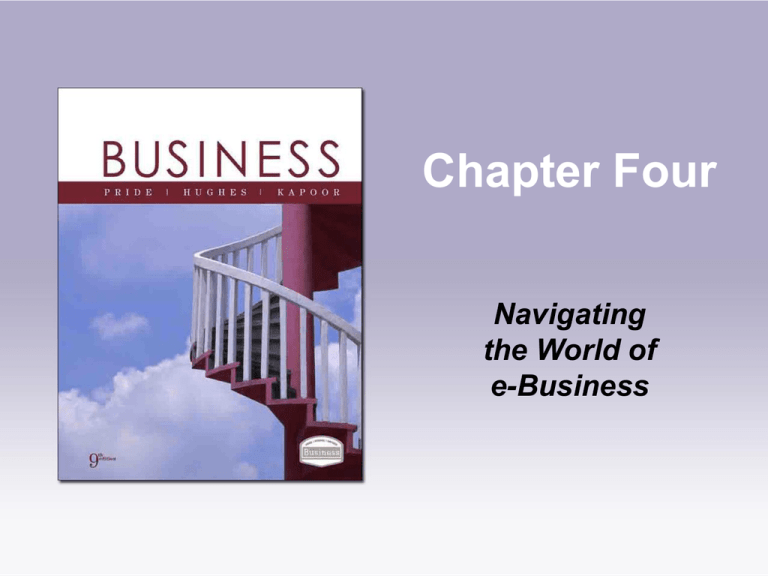Chapter Four Navigating the World of e-Business
advertisement

Chapter Four Navigating the World of e-Business Defining e-Business • e-Business (electronic business)- The organized effort of individuals to produce and sell, for a profit, the products and services that satisfy society’s needs through the facilities available on the Internet • e-Commerce- Buying/selling activities conducted online- Identifying suppliers, selecting products or services, making purchase commitments, completing financial transactions, and obtaining service • Outsourcing- the process of finding outside vendors and suppliers that provide professional help, parts, or materials at a lower cost. Copyright © Houghton Mifflin Company. All rights reserved. 4|2 Combining e-Business Resources Copyright © Houghton Mifflin Company. All rights reserved. 4|3 Satisfying Needs Online • The Internet has created new customer needs • E-business can satisfy those needs as well as traditional ones – Global access to information and entertainment – Virtually unlimited selections of products – Opportunities for interaction – Individually custom-tailored content Copyright © Houghton Mifflin Company. All rights reserved. 4|4 Creating e-Business Profit • Revenue growth – Revenue stream • Source of revenue flowing into a firm – Sales of merchandise online – Intelligent information systems to suggest purchases to repeat online customers – Increased sales in physical stores because of product information available online – Advertising on web pages – Subscription fees charged for access to online services and content Copyright © Houghton Mifflin Company. All rights reserved. 4|5 Creating e-Business Profit (cont’d) • Expense reduction – Offering services that • Reduce transaction costs • Provide information • Provide customer assistance – Reduces the costs of dealing with customers – Reduces the need for as many physical store locations Copyright © Houghton Mifflin Company. All rights reserved. 4|6 Advantages and Disadvantages of e-Business Copyright © Houghton Mifflin Company. All rights reserved. 4|7 A Framework for Understanding e-Business • World Wide Web – The Internet’s multimedia environment of audio, visual, and text data • Digitized data – Data that have been converted to a type of signal that the computers and telecommunications equipment that make up the Internet can understand Copyright © Houghton Mifflin Company. All rights reserved. 4|8 A Brief History of the Internet and e-Business Copyright © Houghton Mifflin Company. All rights reserved. 4|9 The Three Primary Groups of e-Business • The activities of most technology firms overlap into more than one area of e-business Copyright © Houghton Mifflin Company. All rights reserved. 4 | 10 Opportunities in e-Business • Global e-Business – All three primary groups of e-business firms are competing to capture global business – The ability to customize content on the Internet makes it adaptable for global business • Small e-Business – Challenges • Security concerns, technology challenges, products unsuited for selling online – Opportunities • Marketing/advertising, market research, networking with other entrepreneurs, managing accounts, low cost, ability to target a niche, venue for finding an audience, dealing directly with customers Copyright © Houghton Mifflin Company. All rights reserved. 4 | 11 Fundamental Models of e-Business • Business model – A group of common characteristics and methods of doing business to generate sales revenues and reduce expenses • Business-to-Business (B2B) model – Firms that use the Internet to conduct business with other businesses • Facilitating sales transactions between businesses • Elicit bids and offers from suppliers and potential suppliers; learning about the customer’s rules and procedures. Cost savings: reduced labor to enter and track orders and reduced order entry errors Copyright © Houghton Mifflin Company. All rights reserved. 4 | 12 Fundamental Models of e-Business (cont’d) • Business-to-Consumer (B2C) model – Firms that focus on conducting business with individual buyers – Success comes from understanding how the customer behaves online to build good customer relationships Copyright © Houghton Mifflin Company. All rights reserved. 4 | 13 Other e-Business Models Insert table 4.2, 9e with title, p. 127 Copyright © Houghton Mifflin Company. All rights reserved. 4 | 14 Planning for a New Internet Business or Building an Online Presence for an Existing Business Copyright © Houghton Mifflin Company. All rights reserved. 4 | 15 Social and Legal Concerns • Ethics and social responsibility – Opportunity • The Internet provides a shelter of anonymity for both individuals and firms – Privacy issues • Cookie: A small piece of software sent by a website that tracks an individual’s Internet use – Questionable content such as pornography and hate literature Copyright © Houghton Mifflin Company. All rights reserved. 4 | 16 Social and Legal Concerns (cont’d) • Privacy and confidentiality issues – Monitoring employees • Log-file records: Files that store a record of the websites visited – Using and/or selling customer information • Data mining: The practice of searching through data records looking for useful information Copyright © Houghton Mifflin Company. All rights reserved. 4 | 17 Social and Legal Concerns (cont’d) • Security concerns and cybercrime – Computer viruses • Software codes that are designed to disrupt normal computer operations – Fraud and larceny – Secure electronic transaction (SET) • An encryption process developed by MasterCard, Visa, IBM, Microsoft, and Netscape that prevents merchants from ever actually seeing any transaction data, including the customer’s credit card number Copyright © Houghton Mifflin Company. All rights reserved. 4 | 18 Social and Legal Concerns (cont’d) • Digital property and copyright concerns – Copyright • Legal right to control content ownership – Ease of copying and distributing content without permission – Ease of copying and using company name or trademark without permission • Government regulation and taxation – The Internet is an extension of the traditional business and workplace – Online vendors are legally treated like mail-order companies regarding taxes – Sale and distribution of restricted products (such as prescriptions) Copyright © Houghton Mifflin Company. All rights reserved. 4 | 19 The Future of e-Business: Growth, Opportunities, and Challenges • The Internet will continue to expand along with related technologies • Opportunity: Only one billion of the world’s 6 billion people are online • Americans comprise 20 percent of all users—the largest group online. • Of the almost 300 million people making up the American population, 185 million use the Internet— 140 million actively • More than 40% of Americans enjoy fast broadband access at home • American men spend 6.7 hours online per week; and American women spend 5.3 hours per week Copyright © Houghton Mifflin Company. All rights reserved. 4 | 20 Internal and External Forces That Affect an e-Business Copyright © Houghton Mifflin Company. All rights reserved. 4 | 21 Environmental Forces Affecting e-Business • Globalization – Positive: Drawing people of the world together – Negative: A threat to national cultures, identities, languages, ways of life • Convergence of technologies – The overlapping capabilities and the merging of products and services into one fully integrated interactive system Copyright © Houghton Mifflin Company. All rights reserved. 4 | 22 The Future of e-Business: Growth, Opportunities, and Challenges (cont’d) • Online communities – Groups of individuals or firms that want to exchange information, products, or services over the Internet • Partnering online – By playing a role with a large entity, small firms can enjoy competitive advantage and access to marketable items, thereby increasing their rate of market penetration and growth Copyright © Houghton Mifflin Company. All rights reserved. 4 | 23

